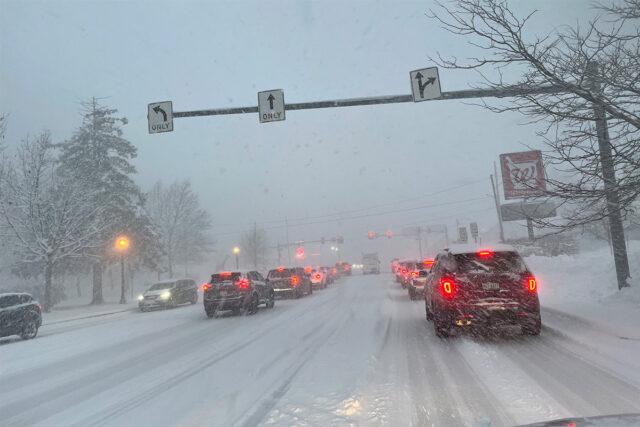
Life-threatening wind chills expected early next week; PEMA working with county partners to make sure they have needed resources to keep people safe
Department of Health provides reminder of signs of hypothermia and urges vulnerable Pennsylvanians – including children and older adults – to stay inside when possible
The Shapiro Administration today urged Pennsylvanians to monitor weather forecasts and take steps now to ensure their safety before life-threatening cold and sub-zero windchills take hold early next week across much of the Commonwealth.
“We expect cold weather this time of year in Pennsylvania, but the extreme cold and windchills that we’re going to see next week mean we all need to make sure that our families and homes are ready for it,” said Pennsylvania Emergency Management Agency (PEMA) Director Randy Padfield. “PEMA will be working with county partners to make sure they have the resources they need to keep people safe throughout this cold snap.”
According to the National Weather Service, January 2018 is the last time Pennsylvania has seen an extended period of bitter cold and dangerous wind chills. Actual air temperatures Monday through Wednesday will range from 15 to 30 degrees below average across the Commonwealth, with some cities expecting records for the coldest high temperatures.
“With extreme temperatures expected across the state, it is important to know the signs of cold-related health concerns and take steps to stay protected, like layering your clothes and covering your head, face and ears even during short trips outdoors,” said Secretary of Health Dr. Debra Bogen. “Do what you can to stay warm and inside. If you do go out, please monitor yourself and others, especially children, older adults and pets, for signs of hypothermia and cold-related injuries.”
HEALTH CONCERNS
The most common cold-related problems are hypothermia and frostbite. Try to stay indoors as much as possible, but if you go outside:
- Make outdoor trips brief and dress warm in layers;
- Cover your ears, head, mouth and face; and
- Never ignore shivering – it’s your body’s way of saying you’re losing heat and it’s time to return indoors.
Know the symptoms of hypothermia and frostbite:
- Hypothermia causes shivering, exhaustion, confusion, memory loss, slurred speech or drowsiness in adults and bright red, cold skin and very low energy in babies.
- Frostbite causes a loss of feeling and color in affected areas, and symptoms include a white or grayish-yellow area of skin, numbness or skin that feels unusually firm or waxy.
Seek medical attention if it is suspected that you or your loved ones have hypothermia or frostbite. Infants and older Pennsylvanians are at greater risk of serious cold-related health issues and should be checked frequently to ensure they are warm enough during cold weather. Provide warm clothing for infants and make sure that those younger than one year old never sleep in a cold room, because they lose body heat more easily than adults and are unable to make enough body heat by shivering.
Older adults often make less body heat because of a slower metabolism and less physical activity. If you are over 65 years of age, check the temperature in your home regularly during extremely cold weather.
The extreme cold can lead some people to use supplemental heating sources in an effort to stay warm or prevent frozen water pipes in their homes. Padfield said you should never try to heat your home using a generator, stove, charcoal grill, camp stove, or other gasoline or charcoal-burning device inside your home, basement, garage or near a window.
Carbon monoxide is created when combustible materials burn incompletely and can build up in enclosed or partially enclosed spaces. Often called “the silent killer,” it is an odorless, colorless, tasteless gas that can incapacitate victims before they’re aware they’ve been exposed. Symptoms of carbon monoxide poisoning are often mistaken for the flu and include nausea, headaches, dizziness, disorientation and fatigue. If you suspect you’ve been exposed to carbon monoxide, leave the home or building immediately and call 9-1-1 or seek medical attention.
TRANSPORTATION CONCERNS
The Pennsylvania Department of Transportation reminds motorists to be aware that winter travel can bring challenging conditions and to always prepare before heading out. Make sure your vehicle is road-ready with a full tank of gas, safe tires, a full reservoir of windshield wiper fluid that is formulated for winter and wiper blades that work well. Have food, water, warm clothing or blankets and any specialized items you may need such as medications or baby and pet supplies in your vehicle throughout the winter months. Motorists should also keep charging cords and spare battery packs, a first aid kit and tools such as a small shovel and flashlight in their cars as well.
Motorists can check conditions on more than 40,000 roadway miles, including color-coded winter conditions on 2,900 miles, by visiting www.511PA.com. 511PA, which is free and available 24 hours a day, provides traffic delay warnings, weather forecasts, traffic speed information and access to more than 1,000 traffic cameras. 511PA is also available through a smartphone application for iPhone and Android devices, by calling 5-1-1, or by following regional X alerts.








